The Essential Role of Drysuits in Kiteboarding
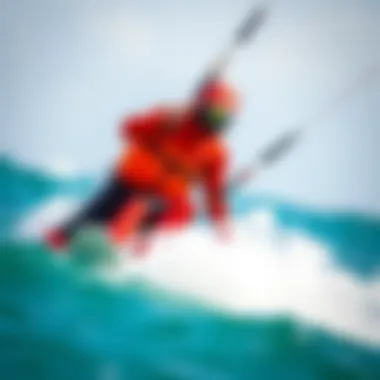
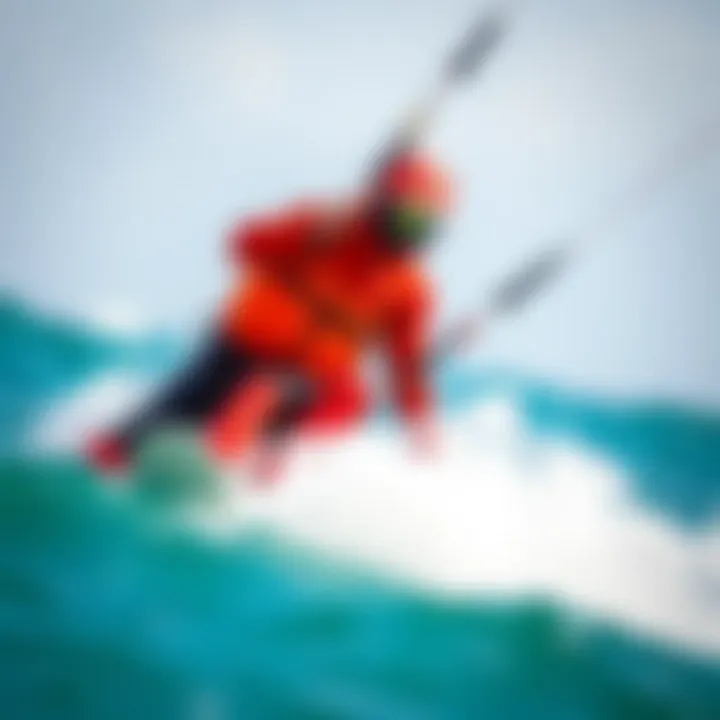
Intro
Kiteboarding, an exhilarating water sport that combines elements of surfing and paragliding, has become increasingly popular among adventure seekers. However, engaging in this thrilling activity mandates adequate preparation, particularly when it comes to gear. One of the most critical pieces of equipment for kiteboarders is the drysuit. Unlike wetsuits, which only provide thermal protection in mild conditions, drysuits are designed to keep water out entirely, ensuring the wearer stays dry and insulated, even in frigid waters.
In this article, we will explore the essential role of drysuits in kiteboarding. Focusing on their design and functionality, we'll discuss the advantages they hold over wetsuits, examine the materials utilized in their construction, and provide guidance on selecting the right suit according to varying weather conditions. Additionally, you will find practical maintenance tips to keep your drysuit in top shape.
Through this comprehensive guide, our aim is to inform and empower kiteboarders from all walks of life, enhancing both safety and performance while navigating the winds and waves.
Prologue to Kiteboarding Drysuits
When embarking on a kiteboarding adventure, understanding the fundamentals of kiteboarding drysuits becomes paramount. These specialized suits not only enhance the overall enjoyment of the sport but also address critical safety and performance needs. In an arena where wind, waves, and unpredictable weather play major roles, drysuits can be the unsung heroes that make a significant difference. They allow enthusiasts to push their limits, whether they are catching air or tackling the gnarly surf.
The essence of a drysuit in kiteboarding lies in its ability to provide warmth and protection. Unlike wetsuits, which allow water to seep in and trap a thin layer against the skin, drysuits are designed to keep water completely at bay. This can emphasize the suit’s importance, especially when temperatures dip. As you might've heard, there’s no point in freezing your tail off when you can stay warm and stylish while riding the waves.
Furthermore, the right drysuit can significantly boost performance, letting riders focus on their skills rather than fighting against the elements. They also come equipped with features catered specifically to kiteboarding, making them a blend of function and fashion on the water. Therefore, this article aims to break down the various aspects associated with kiteboarding drysuits, detailing their design, materials, functionalities, and how to choose the best one suited for your water pursuits.
Defining Drysuits in Water Sports
Drysuits can be best described as full-body suits crafted to prevent water from entering. They are frequently constructed using a combination of waterproof materials and sealed seams. The technology behind drysuits has evolved dramatically over the years, emitting a specific purpose for various water sports, kiteboarding being one of the most demanding.
With a drysuit, users can drastically extend their kiteboarding season, venturing into the chilly waters where wetsuits might fall short. They serve as a barrier against cold water, significantly reducing the risk of hypothermia, thus making them vital for any serious kiteboarder navigating through less-than-ideal conditions. Because when the wind is whipping, it’s all about keeping your body temperature stable and ensuring that you can ride for longer stretches.
Significance for Kiteboarding
In kiteboarding, where your body’s exposure to the elements is constant, the importance of drysuits cannot be overstated. First and foremost, they maintain warmth, allowing you to stay comfortable for hours on the water. Especially during the spring and fall months, when temperatures start to drop, having that layer of protection can mean the difference between a thrilling day out and a shivering retreat back to the shore.
Moreover, drysuits are tailored to accommodate the unique movements required in kiteboarding. They allow for a full range of motion while being tough enough to withstand the rigors of the sport. This specialized design directly impacts your performance, letting you focus on technique rather than the discomfort of the cold.
Additionally, many modern drysuits come with added features like reinforced knees or integrated pockets for essentials, further enhancing their practicality. When it comes to safety, kiteboarding drysuits often include reflective elements that boost visibility in choppy waters, ensuring that safety isn’t compromised amid the thrill of riding. In essence, investing in a high-quality drysuit is not just about comfort; it’s a commitment to better experiences and safer adventures in the world of kiteboarding.
Understanding Drysuit Design
Kiteboarding enthusiasts know that the right gear is essential for enjoying the sport to its fullest. Drysuits, in particular, are designed to provide protection from the elements while maintaining comfort. Understanding drysuit design is important for anyone wanting to get the best performance out of their ride. There are several factors that contribute to a drysuit’s effectiveness, ranging from materials used to construction techniques. Each detail matters, making it vital for both novice and seasoned kiteboarders to grasp these concepts.
Material Composition
Neoprene vs. Gore-Tex
When discussing drysuits, two materials that often come up are neoprene and Gore-Tex. Neoprene is traditionally favored in the realm of water sports for its insulation properties. One of its key characteristics is the thickness that can be adjusted according to water temperature, providing warmth when it's biting cold. However, it can trap heat when the weather warms up, which might leave some users feeling like they are in a sauna.
On the other hand, Gore-Tex is regarded for being waterproof yet exceptionally breathable. It’s often touted as the ‘gold standard’ for many outdoor activities. The unique feature of Gore-Tex is its ability to allow vapor to escape while holding water at bay. This means that even during vigorous activity, users won't feel suffocated by heat build-up. However, many kiteboarders find Gore-Tex drysuits to be pricier and not as insulating as neoprene in colder waters, which can be a crucial consideration when choosing gear.
Breathability and Insulation
Breathability and insulation are pivotal when it comes to staying comfortable and safe in varying water temperatures. Insulation prevents heat loss, crucial during colder months or in frigid waters. Materials such as neoprene offer great warmth due to their dense structure.
In contrast, breathability is about how well air can circulate through the suit to prevent overheating, especially when the sun decides to shine. A drysuit that strikes the right balance between these two characteristics can be a game changer. If a suit feels like a lead blanket, it won't matter how water-resistant it is; riders might simply avoid using it altogether during those warm afternoons.
Construction Techniques
Sealing Methods
The way a drysuit is sealed is just as important as the material it’s made from. A suit with superior sealing methods can block water from creeping in, protecting the user from chills and discomfort. Liquid tape, gaskets, or even glued seams are common sealing techniques that ramp up water resistance.
For instance, liquid-taped seams provide a robust barrier against water, but they can be slightly less flexible. Conversely, gasket seals, found around the neck and wrists, offer a snug fit but might feel constraining for some wearers. Understanding these various sealing methods can help kiteboarders choose a suit that fits their needs, whether it’s for a wild ride or a leisurely day on the water.
Zipper Styles
Zipper styles can also significantly affect the ease of getting in and out of a drysuit. The main styles include standard zippers and waterproof zippers which promise better protection against leaks. Some riders prefer over-the-shoulder zippers, as they offer easier access and can provide a more comfortable fit. However, they can take a longer time to put on and take off than front zippers.
The unique aspect of zipper design in drysuits is their contribution to the overall comfort and usability. A poorly designed zipper might discourage someone from even wearing the suit, particularly if it’s a hassle to get on. A well-placed, high-quality zipper can make all the difference in maintaining the desire for those cold ocean adventures.
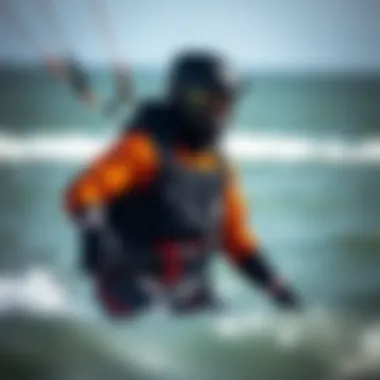
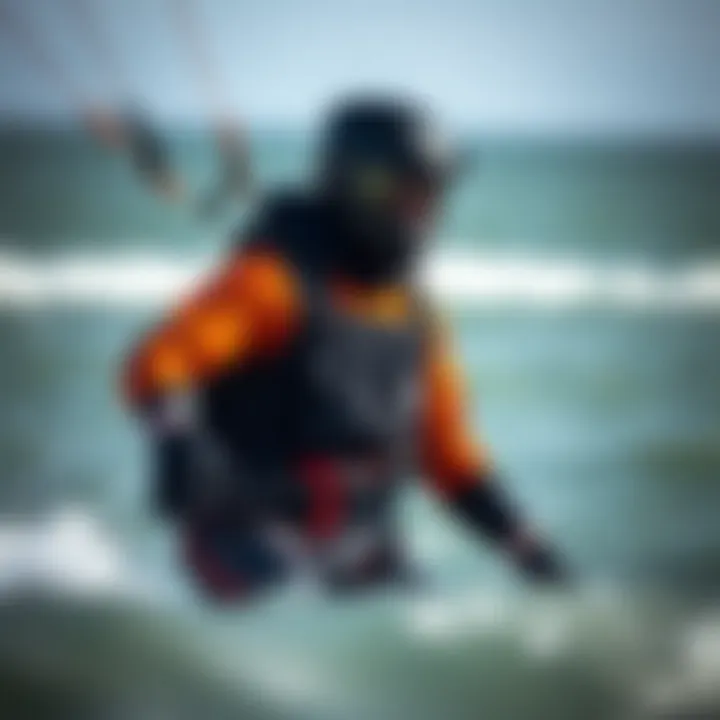
Comparative Analysis: Drysuit vs. Wetsuit
Understanding how drysuits stand up against wetsuits is crucial for any kiteboarding enthusiast. Both options offer their own distinct features, tailored for different water activities and conditions. While each has its purpose, knowing the differences can significantly impact performance and safety.
Temperature Regulation
When it comes to temperature, drysuits and wetsuits operate on fundamentally different principles. Drysuits, as the name suggests, keep the wearer dry. They use waterproof materials, creating a sealed environment that protects against the chilly waters. The key here lies in the layering system. Unlike wetsuits that rely on body heat to warm the trapped water inside them, drysuits allow you to wear insulating layers underneath. This means you can adjust your comfort with the weather, opting for heavier layers in winter or lighter ones in warmer periods.
On the other hand, wetsuits function by allowing a thin layer of water to seep in, which then gets warmed by body heat. This can be efficient in moderate conditions, but becomes a significant disadvantage in frigid waters, where every ounce of heat loss can lead to hypothermia. Essentially, if you're planning to brave the winds and waves in colder climates, a drysuit is your best bet.
Mobility and Comfort
Mobility plays a big role when you're out on the water, jumping and maneuvering on a kiteboard. Drysuits often come equipped with articulated joints and a design that allows for greater freedom of movement. They are often tailored with specific configurations for kiteboarding, ensuring that users can bend their knees, extend their arms, and twist their torso with ease. This ensures that while you’re navigating the elements, you’re not hindered by your gear.
Conversely, wetsuits, particularly those that are snug, can restrict movement if not fitted properly. The thickness of the material can sap some of the mobility, making high-energy moves more challenging. However, most wetsuits also feature a design that allows for flexibility in the shoulders and knees, aimed at enhancing performance. Ultimately, selecting the right suit type is about balancing warmth with the agility you need in kiteboarding or other water sports.
Durability and Longevity
When considering the investment in water gear, durability is a vital factor to consider. Drysuits generally boast a reputation for withstanding rigorous wear and tear. Their heavy-duty construction, often reinforced in areas that face the most abrasion, makes them more robust for frequent use. Furthermore, many drysuits are crafted from advanced materials such as Gore-Tex and proprietary fabrics, designed to withstand the harshest elements, ensuring that they hold up well over time.
In contrast, wetsuits can face issues regarding longevity. The soft neoprene material, while comfortable and flexible, can be subject to rips and tears, especially in cold water where the material could become brittle. Regular maintenance can up their lifespan, but it is still advisable to check for wear and potential damage with every outing.
Factors to Consider When Choosing a Drysuit
Choosing the right drysuit is not simply a matter of picking the most recent model on the market. Rather, it involves a careful evaluation of various factors that can profoundly influence your kiteboarding experience. Drysuits are specifically designed for protection against cold water and harsh conditions, but if the fit, materials or features don’t align with your needs, you may end up compromising comfort and safety. It’s crucial to make informed decisions based on personal preferences and the specific conditions in which you plan to kiteboard.
Fit and Sizing
The fit of a drysuit is one of, if not, the most critical factors to consider. A proper fit enhances mobility while also ensuring that the wearer remains warm. If the suit is too loose, water can seep in, negating the purpose of a drysuit entirely. On the contrary, a suit that is too tight can limit movement and feel uncomfortable, especially when making those sharp turns on the water.
Here are some critical points to consider regarding fit and sizing:
- Try Before You Buy: Always try on the drysuit before purchasing. Ideally, you should wear layers similar to what you’ll use while kiteboarding to gauge the fit accurately.
- Seal Check: Pay attention to the seals around the neck, wrists, and ankles. These areas should offer a snug fit to keep water from entering, yet still allow for some flexibility.
- Freedom of Movement: A well-fitted drysuit should permit adequate body movement without feeling restrictive. This is particularly important during high-energy activities like kiteboarding.
Intended Use and Conditions
When considering a drysuit, it's important to reflect on how and where you plan to use it. The differences between recreational and professional uses can greatly impact your choice.
Recreational vs. Professional
When discussing recreational vs. professional kiteboarding, one must recognize the variances in performance demands. Recreational users may prioritize comfort and ease of wear, while professionals often seek advanced features to enhance performance in competitive situations.
- Key Characteristic: Recreational suits are often designed for versatility, making them adaptable for various activities. This feature allows novices and leisure kiteboarders to feel at ease without overspending on unnecessary high-tech features.
- Advantages: While specifically tailored for the thrill of recreational use, professional suits tend to incorporate cutting-edge materials and configurations. These enhancements can lead to improved performance under extreme conditions.
Cold Water vs. Warm Water
Understanding whether you will be more involved in cold water or warm water kiteboarding is fundamental. Drysuits designed for cold water often have insulation properties that warm you up, while those for warm climates may focus more on breathability.
- Key Characteristic: Cold water suits generally have thicker materials and specialized insulation, which help retain warmth even in frigid conditions. This characteristic can be lifesaving for anyone who might find themselves submerged unexpectedly.
- Unique Features: Warm water drysuits, meanwhile, focus on being lightweight and quick-drying, allowing for easy layering adjustments as water temperatures fluctuate throughout the day.
Choosing the right drysuit requires delving into your personal kiteboarding experience and understanding the conditions you will face. By addressing fit and intended use, one can select a drysuit that not only meets performance needs but also enhances the overall kiteboarding experience. You may not realize it, but these considerations can dramatically impact your time on the water, turning a regular kiteboarding session into a comfortable and exhilarating adventure.
Specific Features of Kiteboarding Drysuits
Kiteboarding drysuits are not just a mundane piece of equipment; rather, they embody essential features that promote both safety and comfort for kiteboarders. This section focuses on the specific attributes that enhance the user experience, ranging from built-in safety measures to practical considerations for portability and storage. Understanding these distinct features helps kiteboarders make informed choices, ensuring their adventures on the water remain enjoyable and safe.
Built-in Safety Features
Reflective Elements
Reflective elements present in drysuits play a critical role in enhancing visibility. When you’re out on the water, especially in low-light conditions, being seen is paramount. These elements are strategically placed, typically on the arms and legs of the suit, to catch the light and stand out. One key characteristic of reflective material is its ability to bounce back light, making it easier for others to spot you in the distance.
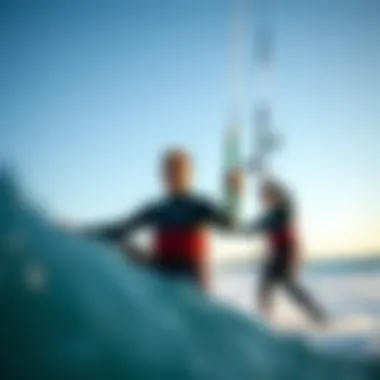
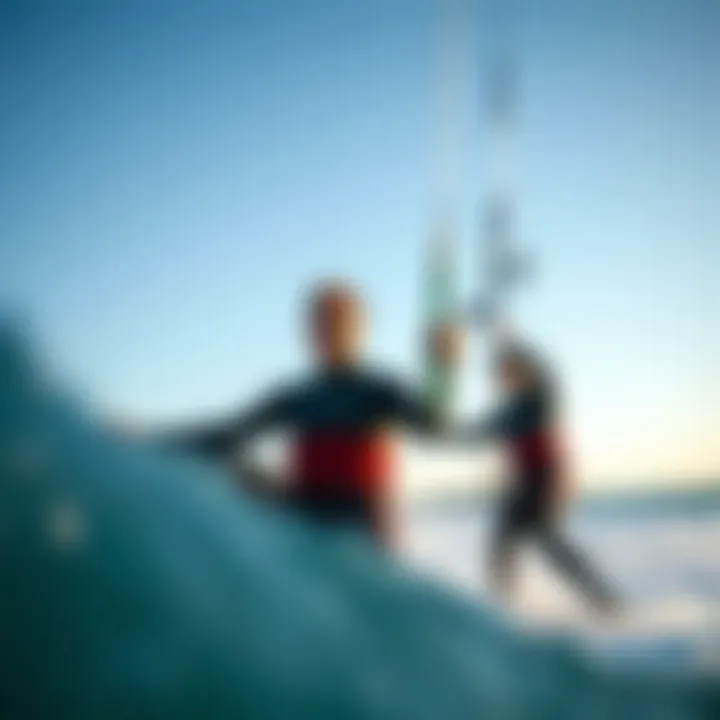
The inclusion of reflective elements is a popular choice among manufacturers because they significantly improve safety. In a sport where conditions can change in a heartbeat, having that extra visibility can be life-saving. One unique feature is their durability. Even after numerous washes and exposure to harsh elements, good quality reflective materials retain their effectiveness, ensuring you have that safety net, regardless of wear and tear. Although the additional cost might deter some, the value placed on one’s safety should outweigh financial considerations.
Emergency Flotation
In kiteboarding, where unintended mishaps occur sometimes, having emergency flotation integrated into a drysuit can act as a crucial safety feature. This flotation material is typically added to specific zones within the suit, such as the chest area, providing buoyancy when you need it most. The core reason for incorporating this feature lies in its potential to save lives in cases of sudden falls or unexpected scenarios.
A notable characteristic of emergency flotation is its lightweight nature. Unlike bulky traditional life vests, this flotation segment of the drysuit doesn’t impede movement, allowing for agile maneuvers on the water. Many kiteboarders appreciate this balance between safety and performance. However, potential disadvantages include the need for regular checks to ensure the buoyancy material remains intact and functioning.
Portability and Storage
Portability is another significant factor that kiteboarders must consider when selecting a drysuit. A well-designed drysuit should not only provide superior protection but also be easy to pack and carry. Lightweight materials along with compact designs are a hallmark of good drysuit construction. This aspect is particularly appealing to those who frequently travel to remote kiteboarding locations.
Storage capabilities can vary widely among different brands and models. Some suits may come equipped with convenient pockets for stashing small gear items, while others may prioritize a streamlined profile. Think about storage solutions that align with your needs. If you find yourself traveling light, a suit that packs down into a compact size could be ideal. However, if convenience matters more, look for options that provide ample pocket space without sacrificing style or function.
Ultimately, these specific features of kiteboarding drysuits evaluate the overall functionality and user experience. Kiteboarding is thrilling, but making the right gear decisions significantly enhances the adventure, helping you ride the waves with confidence.
Maintenance and Care for Drysuits
Understanding the maintenance and care of drysuits is vital to the longevity and performance of this essential kiteboarding gear. By keeping your drysuit in prime condition, not only do you enhance its lifespan but also ensure that it provides maximum insulation and protection while you're out on the water. Properly cared-for drysuits can resist wear and tear, prevent leaks, and maintain the breathability that’s crucial for an enjoyable experience.
Cleaning Protocol
Taking care of your drysuit starts with a thorough cleaning protocol. The saltwater, sand, and debris can settle into the fabric, which lead to an unpleasant experience during your next ride. Here's a simple yet effective cleaning procedure:
- Rinse: After each use, especially in saltwater conditions, rinse the drysuit inside and out with fresh water. This prevents salt crystals from embedding in the material.
- Wash: Use a mild detergent specifically made for neoprene or technical fabrics. Soaking the suit in a tub of lukewarm water with the detergent can help lift stubborn stains.
- Drying: Avoid direct sunlight when drying; instead, hang the suit in a shaded area or a well-ventilated space. Ensure it dries completely before folding it away.
By following these steps, you’ll keep your drysuit not just clean but also free from molds and odors that can render it useless.
Storage Recommendations
When it comes to storing your drysuit, proper conditions make all the difference. Here are a few tips you should consider for optimal storage:
- Choose the Right Place: Store your drysuit in a cool, dry area away from direct sunlight to prevent fading and degradation of materials.
- Hang or Fold Properly: If hanging, use a wide hanger, as a narrow one can stress the shoulders. If folding, avoid putting too many items on top, which can cause creasing and damage.
- Avoid Compression: Ensure the suit is not tightly packed. Compression can affect the material and may lead to leaks in the future.
By adhering to these suggestions, you can safeguard the integrity of your drysuit and ensure it’s ready for action when you are.
Repairing Damages
Accidents happen, even to the best of us. It's essential to know how to quickly and effectively repair any damages to your drysuit, as timely fixes can prevent small issues from becoming major setbacks:
- Identify Damage Early: Regularly inspect your drysuit for small tears or punctures. Catching them early may only require a simple patch.
- Use Appropriate Repair Kits: Many brands offer drysuit repair kits that include adhesive patches designed for your suit materials. Follow the instructions precisely for best results.
- Professional Help: If the damage is extensive or in a critical area (like seams), taking your suit to a professional repair service may be the safest route. They have the tools and expertise to fix it properly, ensuring it’s as good as new.
Being proactive about repairs not only maintains your suit's effectiveness but also contributes to your kiteboarding enjoyment, allowing you to focus on riding rather than worrying about your gear.
Remember, a stitch in time saves nine. Taking these steps can save you money and time down the line!
Exploring Brand Varieties
The landscape of kiteboarding drysuits is rich with variety, played out by numerous manufacturers who continually innovate to meet the specific needs of riders. Understanding these brands is paramount, as each one brings unique qualities and advantages to the table. Engaging with different varieties not only allows kiteboarders to find suits tailored to their preferences but also opens the door to diverse technological advancements that can enhance the overall riding experience.
Top Manufacturers in the Market
When it comes to choosing a drysuit for kiteboarding, some names stand tall among the rest. These manufacturers have earned their stripes through consistent performance and reliability in challenging waters:
- O’Neill – Well-regarded for its blend of comfort and cutting-edge design, O'Neill offers drysuits that cater expertly to both beginners and seasoned pros.
- Hot Tuna – Known for their vibrant designs and durability, Hot Tuna provides a range of products that don’t skimp on style or functionality.
- Patagonia – With a strong focus on sustainability, Patagonia incorporates eco-friendly materials into their line of drysuits, which appeal to the environmentally-conscious rider.
- Mystic – Popular among professionals, Mystic drysuits often include innovative features like built-in impact protection, making them suitable for extreme conditions.
- ION – Balancing flexibility with robust construction, ION’s range often highlights their dedication to providing mobility without sacrificing durability.
Each of these brands offers something different, and noting their unique features and benefits will assist kiteboarders in selecting a suit that maximizes their enjoyment and safety on the water.
Product Range and Innovations
The drysuit market is not just a sea of options but a showcase of remarkable innovations. Each manufacturer lights the way forward in their own way, frequently introducing features that push the envelope of performance:
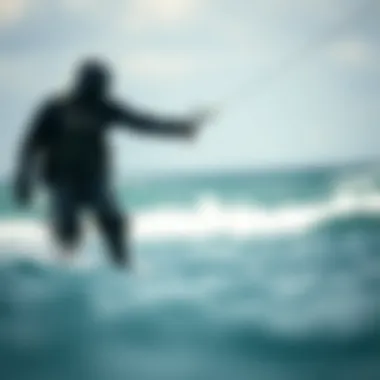
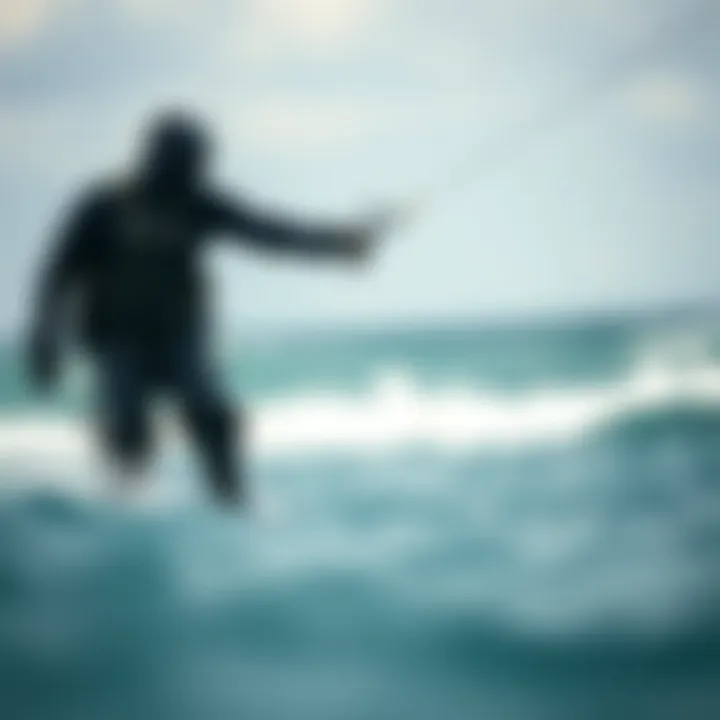
- Material Innovations: New fabric technologies are constantly being developed, enhancing breathability and insulation properties. For instance, Gore-Tex continues to gain traction in drysuit design, delivering exceptional waterproofing without losing breathability.
- Sealing Techniques: Advanced sealing methods are crucial for keeping water at bay. Brands are implementing techniques like liquid tape or airtight zippers to ensure water does not seep in, which is critical during rough conditions.
- Ergonomic Design: Many manufacturers are focusing on the fit and functionality of suits. Instead of merely trading off warmth for flexibility, they have found ways to integrate movement-friendly designs without compromising warmth.
- Tech Integrations: Some newer products are even incorporating tech elements, such as integrated GPS or communication devices, which can come in handy for those pushing their limits or challenging conditions.
As you step into various drysuit offerings, remember that innovation is often what sets apart an average experience from an exceptional one. Taking time to explore these advancements empowers kiteboarders to make informed choices in their equipment selection.
The Environmental Impact of Drysuit Materials
Kiteboarding is an exhilarating sport that connects enthusiasts to the raw power of water and wind. However, with that excitement comes a responsibility towards the environment, especially regarding the materials that make up essential gear like drysuits. This section emphasizes the importance of the impact that drysuit materials can have on our planet, highlighting sustainability practices and the growing need for eco-conscious production methods.
Sustainability in Material Choices
When considering drysuits, it's vital to evaluate the materials used in their construction. Traditionally, many drysuits were made from synthetic materials that, while durable, can contribute to pollution during manufacturing and disposal. Here are some crucial aspects of sustainability in the choice of materials for drysuits:
- Biodegradable options: Some manufacturers are beginning to use biodegradable fabrics that break down more easily in natural environments compared to nylon or PVC, which can linger for decades.
- Eco-friendly production processes: Brands that focus on minimizing waste during manufacturing, using water-based adhesives, and reducing greenhouse gases contribute positively to the environment. These practices appeal not only to eco-conscious consumers but also promote longer-lasting products.
- Recycled materials: The use of recycled plastics and fabrics is a growing trend, which reduces the reliance on virgin resources and diverts waste from landfills. Drysuits made from recycled materials maintain performance while offering an environmentally friendly solution.
Sustainable practices in material selection ensure that kiteboarders can enjoy their sport while feeling responsible about their gear’s environmental footprint.
Recycling Programs
The conversation around drysuits cannot ignore the importance of recycling initiatives. As kiteboarders upgrade their gear or find their suits aging, making use of recycling programs can significantly reduce environmental impact. Consider these aspects of recycling programs related to drysuit materials:
- Old gear collection: Many brands are establishing systems to take back old or damaged drysuits, ensuring they don’t end up in landfills. Instead, these old suits can be repurposed or recycled into new products.
- Material recovery and transformation: Through recycling efforts, drysuits can be transformed into different materials. Companies may turn them into new fabrics or components for various applications, from surfboards to insulation materials.
- Educating consumers: Brands involved in recycling not only focus on the process but also aim to educate their customers about responsible disposal and the environmental impacts of their purchases. This awareness fosters a community that values sustainability.
"Every small action counts. When we recycle our drysuits, we contribute to a larger movement toward environmental sustainability in water sports."
User Experiences and Testimonials
User experiences and testimonials serve as the backbone of understanding how kiteboarding drysuits function in real-world environments. When considering a drysuit, kiteboarders often rely on feedback from fellow riders to guide their purchase decisions. This section explores the nuanced perspectives of both amateur kiteboarders and seasoned professionals, providing insights into the practical advantages and challenges associated with different drysuits.
Insights from Amateur Kiteboarders
Amateur kiteboarders tend to bring a refreshing perspective when discussing the functionality of drysuits. Many of them are just starting to navigate the complexities of the sport, and their feedback is often rooted in their desire for comfort and usability. A common sentiment among beginners is the importance of fit. Many emphasize that a well-fitted drysuit allows for freedom of movement and ensures that they aren't hindered while trying to master their kite control.
Still, other newbies voice concerns about the weight and bulkiness of certain brands. They note that on particularly warm days, it sometimes feels like they’re wrapped in a sauna instead of a protective suit. Hence, breathability becomes a hot topic in amateur discussions.
"I thought all drysuits would be the same, but the cut makes all the difference! I felt like a fish out of water in one that was too tight!"
Overall, amateur experiences often highlight the suitability of materials for beginners. Many express their preference for lightweight, neoprene options, which ease the learning curve while also being versatile enough for varying water temps. Recommendations among these kiteboarders also frequently include tips for layering, as many feel that knowing how to wear suitable thermal undergarments helps them adapt their suit to cold water conditions.
Feedback from Professional Riders
Professional kiteboarders bring a wealth of experience and technical insight into the discussion of drysuits. With years spent navigating varying conditions, their feedback focuses on durability, performance, and specific features that can make or break a session.
One key aspect raised by professionals is the importance of sealing methods. They often argue that a well-sealed neck and wrist can dramatically reduce water ingress, making for a more enjoyable ride. Several pros mention specific brands that have nailed this design element, asserting that they refuse to ride in a suit that doesn’t meet these high standards.
Performance is another pivotal topic among elite riders. They commonly test materials during extreme weather conditions, pushing the limits of breathability and flexibility. Many highlight how advanced fabric technology, such as lightweight Gore-Tex, allows them to stay dry while also maintaining ease of movement. They stress that comfort and performance are paramount, especially during intense sessions where distractions can hinder performance.
Furthermore, professional riders frequently comment on the need for customized features—like reinforced knees and anti-slip zones—adapted to their unique riding styles. This level of personal preference emphasizes the necessity for commitment to a specific brand that caters well to their needs.
In summation, testimonials from both amateur and professional kiteboarders unveil a mosaic of experiences that underscore the vital role of drysuit innovation in enhancing the kiteboarding experience. Each view contributes to a holistic understanding of what makes a drysuit effective, and it’s clear that rider feedback is invaluable in shaping future design trends and functionalities in the market.
Future Trends in Drysuit Development
The world of kiteboarding is not just shaped by wind and water but also by innovations in gear that enhance performance and safety. Among these innovations, drysuits play a crucial role. As kiteboarding grows in popularity, the materials and technologies that make up these suits are evolving rapidly. Understanding the future trends in drysuit development is essential, as it directly influences how enthusiasts experience the sport. Each advancement contributes to improved functionality, which can make a significant difference in both safety and enjoyment on the water.
Technological Advancements
In recent years, the kiteboarding industry has witnessed a host of technological advancements focused on enhancing drysuit design. These improvements aren’t just cosmetic; they redefine user experience. For instance, one of the most notable developments is in the area of smart fabrics. Imagine a drysuit that can regulate temperature according to body heat; this is moving from science fiction to reality. Smart fibers can adjust insulation levels, allowing kiteboarders to maintain optimal comfort regardless of the weather conditions.
Another exciting advancement is the integration of lightweight, durable materials that resist wear and tear better than traditional options. This has resulted in drysuits that are easier to move in while also being more buoyant and less cumbersome. On top of that, innovations in sealing technology, such as better gaskets and waterproof zippers, significantly reduce the risk of water ingress, keeping kiteboarders dry and warm.
"As technology keeps pushing boundaries, the kiteboarding community will adapt to gear that not only protects but enhances performance."
Predicted Market Changes
As we look ahead, the drysuit market is set to experience substantial changes influenced by various factors. One major trend is the increasing demand for eco-friendly products. As environmental concerns grow, manufacturers are likely to embrace sustainable materials and production methods. Kiteboarders are becoming more mindful about the ecological impact of their gear, leading brands to prioritize sustainability over mere performance.
Furthermore, customization is becoming a significant buzzword in the drysuit industry. Consumers are seeking more personalized options, which cultivate a sense of ownership and enhance user satisfaction. This demand might lead to brands offering custom-fit solutions or options for different activities such as racing or recreational kiteboarding.
In addition to eco-friendly solutions and customization, we can expect to see a surge in the affordability of advanced drysuits. As technology advances and production methods improve, previously high-end features will become more accessible to the average kiter. This democratization of technology can lead to increased participation in the sport, fostering a more vibrant community and elevating kiteboarding as a popular water activity.







